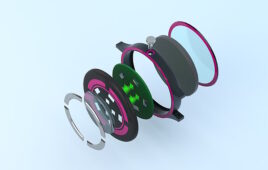Written by Mark Jones

The medical industry benefits from pressure-sensitive adhesive products, which are used in surgical tapes, dressing films, and applications that require low skin irritation, flexibility, and strength.
Stamps used to be something you’d lick before placing on an envelope. Now, they’re something you peel. Peeling a stamp off its backing sheet exposes a pressure-sensitive adhesive (PSA).
Also known as pressure adhesive or self-adhesive, they’re typically used for tape (single or double-sided), stickers, and envelopes. Often PSAs are strongly bound to a substrate, as with tape. Other times, resins must be applied. The form matters little if at all because how they work is the same.
A sticky resin flows onto the surface or surfaces to be joined. PSAs are non-reactive adhesives. No chemistry must occur to form the bond. It forms from the resin film’s viscosity combined with the molecular interactions. It can be strong, like the backing used on some carpet installations, or weak, like a Post-It note.
Surface prep is critical for proper bonding. A smooth surface free of contaminants. PSAs work best at room temperature. They lose their tack at low temperatures because the rubbery polymers grow stiff. At high temperatures, the viscosity of the adhesive drops.
PSAs can be natural but are usually synthetic. Most are coated onto a flexible substrate, such as tape or stickers. Rubbery acrylic polymers, applied from solvent and emulsions, are common. Rubbers are also used, which are applied from solvent or as a melt.
More recently, UV-curable resins have been finding greater use. Applied solvent-free and cured on a substrate, they let manufacturers meet stricter environmental regulations relating to the atmospheric release of volatiles. UV-curable resins are sold as liquids, putties, or gels. Rubber cement and Blu Tack putty are also PSAs.
Many adhesives transform when forming a bond. They harden, solidify, or cure. There’s a before and after. A chemical reaction, solvent evaporation, or transition phase occurs as the adhesive cools, which gives it a different appearance than earlier. This is not the case with most PSAs.
When a pressure-sensitive adhesive bonds, there’s no chemical or compositional change. PSAs are typically tacky polymers that do not harden.
To be fair, many start their lives as solvent-borne or other mixtures, applied to a carrier, a film, foil, paper, or cloth, and then dried. The PSA is sold attached to the carrier (again, like tapes or stickers). The solvent and coating are completed during manufacturing, leaving the user to peel and stick. The advantage is there are no volatile solvents or mess.

Pressure-sensitive adhesives are glues that bond surfaces when pressed together. Examples include electrical, packing, and duct tape.
However, resourceful chemists continue to innovate, and blanket statements are difficult to make. Some types of pressure adhesive undergo secondary hardening over time, causing the bond strength to increase — sometimes over several days.
Even with typical PSAs, the bond strength often increases gradually over a few days. Tapes and stickers can, therefore, usually be repositioned a few minutes after attachment and will be more challenging to move days after placement.
This trait varies with the formula and some PSAs are reusable after long periods of use. Time can also be detrimental. Migration of plasticizers from the substrate into the adhesive layer can weaken it.
PSAs, particularly those sold on a carrier, are some of the safest adhesives. The dried adhesives are also safe, but those sold as solvent emulsions carry hazards associated with the solvents.
Some common pressure-sensitive adhesives include:
- Duct tape – a heavy-duty self-adhesive fabric tape widely used for general repairs and sealing insulation.
- Insulation or electrical tape – used to insulate electrical wires and fittings. It’s typically a stretchy vinyl tape with pressure-sensitive adhesive on one side.
- Sticky tape – also known as sticky-backed plastic or by the brand names Scotch Tape and Sellotape, is usually a translucent polypropylene tape for general household and office use. It’s also commonly used to hold wrapping paper.
- Packing tape – also known as parcel or box-sealing tape, it’s similar to household sticky tape with a wider dispensing roll. As the name implies, it’s typically used for sealing cardboard and packing boxes.
- Mounting putty – such as Blu Tack or Poster Putty, is a mass of pressure-sensitive adhesive. It can be broken into pieces and is often used to stick posters to the wall to avoid damage to the paint.
- Spray adhesives – generally unreactive, solvent-borne pressure-sensitive adhesives.
- Flooring – peel-and-stick carpet squares use PSA, avoiding the mess and volatile emissions associated with traditional carpet adhesives.
- Industrial PSAs – are growing in use, typically for the attachment of panels in automotive, parts in electronics, and other industries. The ease of automation and reduced solvent use makes PSAs attractive.









Tell Us What You Think!